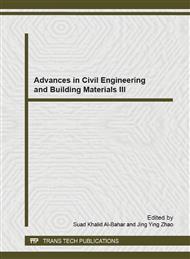[1]
Arriaga, F., 2003. Response of geosynthetic-reinforced structures under working stress and failure conditions, Ph.D. Thesis, University of Colorado at Boulder, Boulder, Colorado, USA, 205p.
Google Scholar
[2]
Jaber, M. B., 1989. Behavior of reinforced soil walls in centrifuge model tests. Berkeley, Ph.D. Thesis, University of California, Berkeley, 239p.
Google Scholar
[3]
ASTM D4595, Standard test method for tensile properties of geotextiles by the wide-width strip method, American Society for Testing and Materials, West Conshohocken, Pennsylvania, USA.
DOI: 10.1520/d4595-05
Google Scholar
[4]
Costa, C. M. L., 2004. Time-dependent deformations in geotextile reinforced soil walls, Ph.D. Thesis, School of Engineering at Sao Carlos, University of Sao Paulo, Sao Carlos, Sao Paulo, Brazil, 330p. (in Portuguese).
DOI: 10.15584/ejcem.2022.3.10
Google Scholar
[5]
Zornberg, J. G. and Arriaga, F., 2003, Strain Distribution within Geosynthetic-Reinforced Slopes. Journal of Geotechnical and Geoenvironmental Engineering, v. 129, n. 1, 32-45.
DOI: 10.1061/(asce)1090-0241(2003)129:1(32)
Google Scholar
[6]
Zornberg, J. G., 1994, Performance of geotextile-reinforced soil structures. Ph.D. Thesis, University of California, Berkeley, California, USA.
Google Scholar
[7]
Zornberg, J. G., Sitar, N., and Mitchell, J. K., 1998, Performance of geosynthetic reinforced slopes at failure. Journal of Geotechnical and Geoenvironmental Engineering, v. 124, n. 8, 670-683.
DOI: 10.1061/(asce)1090-0241(1998)124:8(670)
Google Scholar
[8]
Wilson-Fahmy, R. F., Koerner, R. M. and Fleck, J. A., 1993, Unconfined and confined wide width tension testing of geosynthetics. In: Cheng, S. J. C. Geosynthetics soil reinforcement testing procedures. Philadelphia, pp.49-63.
DOI: 10.1520/stp24312s
Google Scholar
[9]
Ballegeer, J. P., Wu, J. T. H., 1993. Intrinsic confined and unconfined load-deformation properties of geotextiles. In: Cheng, S. J. C. Geosynthetics soil reinforcement testing procedures. Philadelphia. pp.16-31.
DOI: 10.1520/stp24310s
Google Scholar
[10]
Christopher, B. R., Holtz, R. D. and Bell, W. D., 1986, New tests for determining the in-soil stress-strain properties of geotextiles. Proceedings of the Third International Conference on Geotextiles, Vienna, Austria, 3, 683-688.
Google Scholar


